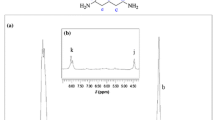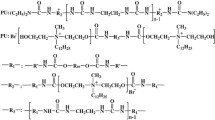Abstract
An antibacterial PU coating with QAS was developed from polycarbonate diol (PCDL), 4,4'-Diphenylmethane diisocyanate (MDI), 3-dimethylamino-1,2-propanediol (DMAPD) and 1-bromododecane. The structural composition and surface morphology of this PU coating were characterized by X-ray photoelectron spectroscopy (XPS), Fourier transform infrared spectroscopy (FT-IR) and scanning electron microscope (SEM). Besides, the QAS-bearing PU showed markedly antimicrobial activity against both gram-positive Staphylococcus aureus (S. aureus) and gram-negative Escherichia coli (E. coli). The samples were marked as PU-2, PU-3, PU-4, PU-5, PU-6 and PU-7 according to the different theoretical molar fraction of DMAPD in chain extenders, which were 20, 30, 40, 50, 60 and 70%, respectively. Apparently, PU-4 coating showed the best antibacterial activity against S. aureus, whereas PU-5 against E. coli.












Similar content being viewed by others
References
Rahma H, Asghari S, Logsetty S (2015) Preparation of Hollow N-Chloramine-Functionalized Hemispherical Silica Particles with Enhanced Efficacy against Bacteria in the Presence of Organic Load. ACS Appl Mater Interfaces 7:11536–11546
Sehmi SK, Noimark S, Weiner J (2015) Potent Antibacterial Activity of Copper Embedded into Silicone and Polyurethane. ACS Appl Mater Interfaces 7:22807–22813
Donlan RM, Costerton JW (2002) Biofilms: Survival mechanisms of clinically relevant microorganisms. Clin Microbiol Rev 15:167
Wu J, Zhu J, He C (2016) Comparative Study of Heparin-Poloxamer Hydrogel Modified bFGF and aFGF for in Vivo Wound Healing Efficiency. ACS Appl Mater Interfaces 8:18710–18721
Murata H, Koepsel RR, Matyjaszewski K, Russell AJ (2007) Permanent, non-leaching antibacterial surfaces - 2: How high density cationic surfaces kill bacterial cells. Biomaterials 28:4870–4879
Wiegand A, Buchalla W, Attin T (2007) Review on fluoride-releasing restorative materials - Fluoride release and uptake characteristics, antibacterial activity and influence on caries formation. Dent Mater 23:343–362
Valsami-Jones E, Lynch I (2015) How safe are nanomaterials? Science 350:388–389
Boda SK, Broda J, Schiefer F (2015) Cytotoxicity of Ultrasmall Gold Nanoparticles on Planktonic and Biofilm Encapsulated Gram-Positive Staphylococci. Small 11:3183–3193
Dinali R, Ebrahiminezhad A, Manley-Harris M (2017) Iron oxide nanoparticles in modern microbiology and biotechnology. Crit Rev Microbiol 43:493–507
Chattopadhyay DK, Raju KVSN (2007) Structural engineering of polyurethane coatings for high performance applications. Prog Polym Sci 32:352–418
Siedenbiedel F, Tiller JC (2012) Antimicrobial Polymers in Solution and on Surfaces: Overview and Functional Principles. Polymers 4:46–71
Fuchs AD, Tiller JC (2006) Contact-active antimicrobial coatings derived from aqueous suspensions. Angew Chem-Int Edit 45:6759–6762
Hoffman LR, D’Argenio DA, MacCoss MJ (2005) Aminoglycoside antibiotics induce bacterial biofilm formation. Nature 436:1171–1175
Sambhy V, MacBride MM, Peterson BR, Sen A (2006) Silver bromide nanoparticle/polymer composites: Dual action tunable antimicrobial materials. J Am Chem Soc 128:9798–9808
Kumar A, Vemula PK, Ajayan PM, John G (2008) Silver-nanoparticle-embedded antimicrobial paints based on vegetable oil. Nat Mater 7:236–241
Xu Y, Wen W, Wu J-M (2018) Titania nanowires functionalized polyester fabrics with enhanced photocatalytic and antibacterial performances. J Hazard Mater 343:285–297
Cheng L, Weir MD, Zhang K (2012) Antibacterial Nanocomposite with Calcium Phosphate and Quaternary Ammonium. J Dent Res 91:460–466
Mondello V, Songy A, Battison E (2018) Grapevine Trunk Diseases: A Review of Fifteen Years of Trials for Their Control with Chemicals and Biocontrol Agents. PLANT DIS 102:1189–1217
Guo Y, Sun Q, Wu F-G (2021) Polyphenol-Containing Nanoparticles: Synthesis, Properties, and Therapeutic Delivery. Adv Mater 33:2007356
Fan X, Hu M, Qin Z (2018) Bactericidal and Hemocompatible Coating via the Mixed-Charged Copolymer. ACS Appl Mater Interfaces 10:10428–10436
He W, Zhang Y, Li J (2016) A Novel Surface Structure Consisting of Contact-active Antibacterial Upper-layer and Antifouling Sub-layer Derived from Gemini Quaternary Ammonium Salt Polyurethanes. Sci Rep 6:32140
Wang H, Shi X, Yu D (2015) Antibacterial Activity of Geminized Amphiphilic Cationic Homopolymers. Langmuir 31:13469–13477
Gusarov I, Shatalin K, Starodubtseva M, Nudler E (2009) Endogenous Nitric Oxide Protects Bacteria Against a Wide Spectrum of Antibiotics. Science 325:1380–1384
Yu N, Li J, Ma F (2020) Preparation and Properties of Cationic Gelatin Cross-Linked with Tannin. J Agric Food Chem 68:9537–9545
**e D, Howard L, Almousa R (2018) Surface modification of polyurethane with a hydrophilic, antibacterial polymer for improved antifouling and antibacterial function. J Biomater Appl 33:340–351
Banerjee I, Pangule RC, Kane RS (2011) Antifouling Coatings: Recent Developments in the Design of Surfaces That Prevent Fouling by Proteins, Bacteria, and Marine Organisms. Adv Mater 23:690–718
Tan H, Peng Z, Li Q (2012) The use of quaternised chitosan-loaded PMMA to inhibit biofilm formation and downregulate the virulence-associated gene expression of antibiotic-resistant staphylococcus. Biomaterials 33:365–377
Buffet-Bataillon S, Tattevin P, Bonnaure-Mallet M, Jolivet-Gougeon A (2012) Emergence of resistance to antibacterial agents: the role of quaternary ammonium compounds-a critical review. Int J Antimicrob Agents 39:381–389
Zhu C, Yang Q, Liu L (2011) Multifunctional Cationic Poly(p-phenylene vinylene) Polyelectrolytes for Selective Recognition, Imaging, and Killing of Bacteria Over Mammalian Cells. Adv Mater 23:4805
Zhang Y, He X, Ding M (2018) Antibacterial and Biocompatible Cross-Linked Waterborne Polyurethanes Containing Gemini Quaternary Ammonium Salts. Biomacromol 19:279–287
Ganewatta MS, Miller KP, Singleton SP (2015) Antibacterial and Biofilm-Disrupting Coatings from Resin Acid-Derived Materials. Biomacromol 16:3336–3344
Galie S, Garcia-Gutierrez C, Miguelez EM (2018) Biofilms in the Food Industry: Health Aspects and Control Methods. Front Microbiol 9:898
Chen A, Peng H, Blakey I, Whittaker AK (2017) Biocidal Polymers: A Mechanistic Overview. Polym Rev 57:276–310
Zhao J, Ma L, Millians W (2016) Dual-Functional Antifogging/Antimicrobial Polymer Coating. ACS Appl Mater Interfaces 8:8737–8742
He W, Zhang Y, Luo F (2015) A novel non-releasing antibacterial poly(styrene-acrylate)/waterborne polyurethane composite containing gemini quaternary ammonium salt. RSC Adv 5:89763–89770
Ye S, Majumdar P, Chisholm B (2010) Antifouling and Antimicrobial Mechanism of Tethered Quaternary Ammonium Salts in a Cross-linked Poly(dimethylsiloxane) Matrix Studied Using Sum Frequency Generation Vibrational Spectroscopy. Langmuir 26:16455–16462
Wang Y, Chen R, Li T (2020) Antimicrobial Waterborne Polyurethanes Based on Quaternary Ammonium Compounds. Ind Eng Chem Res 59:458–463
Zhao J, Millians W, Tang S (2015) Self-Stratified Antimicrobial Acrylic Coatings via One-Step UV Curing. ACS Appl Mater Interfaces 7:18467–18472
Fu X, Jenkins MJ, Sun G (2012) Characterization of active screen plasma modified polyurethane surfaces. Surf Coat Technol 206:4799–4807
Stanczyk K, Dziembaj R, Piwowarska Z, Witkowski S (1995) Transformation of Nitrogen Structures in Carbonization of Model Compounds Determined by Xps. Carbon 33:1383–1392
Kincal D, Ozkar S (1997) Kinetic study of the reaction between hydroxyl-terminated polybutadiene and isophorone diisocyanate in bulk by quantitative FTIR spectroscopy. J Appl Polym Sci 66:1979–1983
Daud FN, Ahmad A, Badri KH (2014) An Investigation on the Properties of Palm-Based Polyurethane Solid Polymer Electrolyte. Int J Polym Sci 2014:326716
Ding M, Li J, Fu X (2009) Synthesis, Degradation, and Cytotoxicity of Multiblock Poly(epsilon-caprolactone urethane)s Containing Gemini Quaternary Ammonium Cationic Groups. Biomacromol 10:2857–2865
Kim CH, Choi JW, Chun HJ, Choi KS (1997) Synthesis of chitosan derivatives with quaternary ammonium salt and their antibacterial activity. Polym Bull 38:387–393
Wang H, Zhou Y, He M, Dai Z (2015) Effects of soft segments on the waterproof of anionic waterborne polyurethane. Colloid Polym Sci 293:875–881
Bakhshi H, Yeganeh H, Mehdipour-Ataei S (2013) Synthesis and characterization of antibacterial polyurethane coatings from quaternary ammonium salts functionalized soybean oil based polyols. Mater Sci Eng, C 33:153–164
Chung YC, Su YP, Chen CC (2004) Relationship between antibacterial activity of chitosan and surface characteristics of cell wall. Acta Pharmacol Sin 25:932–936
Bruinsma GM, van der Mei HC, Busscher HJ (2001) Bacterial adhesion to surface hydrophilic and hydrophobic contact lenses. Biomaterials 22:3217–3224
Lin J, Wang Y, Wei X (2020) Controllable antibacterial and bacterially anti-adhesive surface fabricated by a bio-inspired beetle-like macromolecule. Int J Biol Macromol 157:553–560
Chen R, Li T, Zhang Q (2017) Design of polyurethane acrylic antimicrobial films via one-step UV curing. New J Chem 41:9762–9768
Lundin JG, Giles SL, Fulmer PA, Wynne JH (2017) Distribution of quaternary ammonium salt encapsulated polyoxometalates in polyurethane films. Prog Org Coat 105:320–329
Aydin A, Demirci F, Orhan M, Kocer HB (2019) Preparation of breathable polyurethane membranes with quaternary ammonium salt diols providing durable antibacterial property. J Appl Polym Sci 136:47133
Wang X, Nakamoto T, Dulińska-Molak I (2016) Regulating the stemness of mesenchymal stem cells by tuning micropattern features. J Mater Chem B 4:37–45
Roguska A, Belcarz A, Pisarek M (2015) TiO2 nanotube composite layers as delivery system for ZnO and Ag nanoparticles - An unexpected overdose effect decreasing their antibacterial efficacy. Mater Sci Eng C-Mater Biol Appl 51:158–166
Sridhar R, Sundarrajan S, Vanangamudi A (2014) Green Processing Mediated Novel Polyelectrolyte Nanofibers and Their Antimicrobial Evaluation. Macromol Mater Eng 299:283–289
Wang R, **ang T, Zhao W-F, Zhao C-S (2016) A facile approach toward multi-functional polyurethane/polyethersulfone composite membranes for versatile applications. Mater Sci Eng, C 59:556–564
Bakhshi H, Agarwal S (2017) Hyperbranched polyesters as biodegradable and antibacterial additives. J Mat Chem B 5:6827–6834
Mathew RT, Cooney RP, Doyle CS (2020) Anchored quaternary ammonium salts adsorbed on polyurethane film surfaces. Prog Org Coat 138:105343
Coneski PN, Weise NK, Fulmer PA, Wynne JH (2013) Development and evaluation of self-polishing urethane coatings with tethered quaternary ammonium biocides. Prog Org Coat 76:1376–1386
Lynn AD, Blakney AK, Kyriakides TR, Bryant SJ (2011) Temporal progression of the host response to implanted poly(ethylene glycol)-based hydrogels. J Biomed Mater Res Part A 96:621–631
Author information
Authors and Affiliations
Corresponding authors
Ethics declarations
Conflicts of interest
The authors declare that they have no conficts of interest for the submitted work.
Additional information
Publisher's Note
Springer Nature remains neutral with regard to jurisdictional claims in published maps and institutional affiliations.
Rights and permissions
About this article
Cite this article
Wang, Y., Du, J., Guo, H. et al. The antibacterial activity and mechanism of polyurethane coating with quaternary ammonium salt. J Polym Res 29, 47 (2022). https://doi.org/10.1007/s10965-022-02904-y
Received:
Accepted:
Published:
DOI: https://doi.org/10.1007/s10965-022-02904-y




